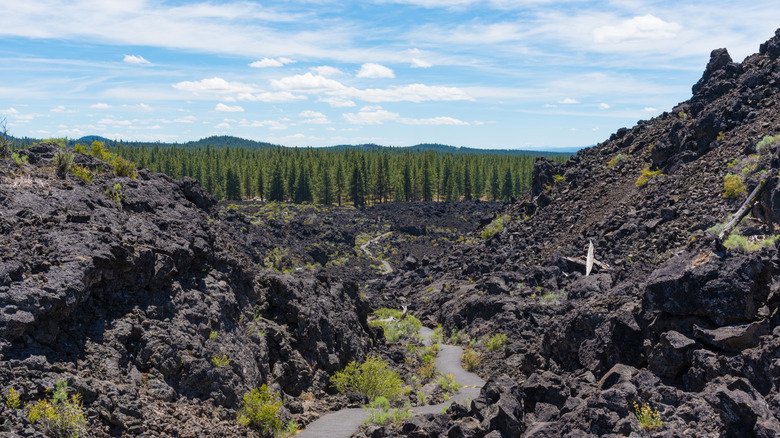Oregon's Most Claustrophobic Hike Is A Short Lava Tube Not For The Faint-Hearted
Oregon has no shortage of staggering natural beauty, from prominent icons like Mount Hood to under-the-radar marvels like the secret "Iceland-esque" Abiqua Falls just south of Portland. Yet Oregon's geological spectacles are not limited to the world above the surface. Below ground, Oregon features a notable network of caves leftover from the region's epic volcanic history. One of these, the subterranean Boyd Cave, is simultaneously one of Oregon's most foreboding and most exquisite natural attractions.
No cave on Earth would be an "ideal" destination for individuals with claustrophobia, but even in the constrained context of spelunking, Boyd Cave stands out for some cramped quarters. While many popular show caves have artificially expanded corridors and infrastructure that make a visit much more manageable, Boyd Cave still features narrow passages that require literally crawling on your hands and knees, often over rough and rocky terrain. In short, Boyd Cave is not the place you want to go if you don't like confined spaces.
On the other side of the coin, Boyd Cave's rugged and undeveloped character represents a kind of distinct, dream-like beauty rarely found in public lands. Much of the cave's strange beauty stems from its violent origins. For all its dark tranquility today, Boyd Cave is the product of the fiery volcanic history that shaped much of Oregon's landscapes. Taken together, all of these factors mean that Boyd Cave is decidedly not for the faint of heart. However, if you're willing to make the cramped and claustrophobic journey through its dark corridors, Boyd Cave offers the unforgettable experience of descending through a living remnant of Earth's most tempestuous heritage. Plus, Boyd Cave sits in the middle of one of Oregon's most spectacular — and most underrated — parks, near one of Oregon's most charming cities.
Boyd Cave is one of Oregon's most haunting volcanic wonders
Oregon is no stranger to volcanoes. Sitting firmly within the Cascade Volcanic Arc, part of the much larger Pacific Ring of Fire, Oregon bears a landscape that's been notably shaped by volcanic activity over the years. Though not nearly as prominent as the towering Mount Hood or the Crater Lake caldera, Boyd Cave is nonetheless a remarkable remnant of a violent volcanic heritage.
Boyd Cave is a prime example of a lava tube. As the name suggests, a lava tube is a literal "tube" of igneous rock formed by the hardening of lava from a volcanic eruption. Lava tubes offer a distinct subterranean experience compared to limestone caverns and other types of caves. Due to their volcanic origin, lava tubes tend to feature much darker rock, like basalt, and generally have longer, tunnel-like chambers. They also offer the adrenaline-inducing experience of walking through what was once a conduit of molten lava!
Boyd Cave's status as a lava tube means narrow, jet black tunnels and a floor adorned with sharp volcanic rocks. The cave contains several eye-catching basalt rock formations, including a unique type of smooth, "flowing" basalt called a pahoehoe. The entire trail through the cave is only around 0.75 miles and relatively flat, but its dimensions are a bit nerve-racking in a different way. The cave's ceiling narrows to around 5 feet off the ground in places, meaning taller spelunkers will often have to crouch down (or even crawl) at points. As such, Boyd Cave is not ideal for anyone with claustrophobia. Additionally, access to the cave requires descending a steep metal staircase through a small ground-level opening. The cave is also rather chilly, with a consistent temperature of around 42 degrees Fahrenheit. So, bring a jacket.
Boyd Cave sits in the heart of Oregon's most volcanic park
Narrow passages aside, the Boyd Cave Trail is not too challenging. Stairs included, the entire out-and-back journey will take only an hour or so. Though do note that you will need to bring a headlamp or flashlight (preferably several) to navigate the extremely dark interior. And while exploring the inside of a 400,000-year-old lava tube is thrilling, the area outside the cave is just as worth a visit.
Boyd Cave is part of Oregon's epic Newberry National Volcanic Monument, part of the larger Deschutes National Forest. The same volcanic forces that created Boyd Cave also created the massive Newberry Caldera and the surrounding 54,000 acres of magnificent volcanic landscapes. If you're a volcano aficionado, you can easily supplement your visit to the Boyd Cave lava tube with much longer adventures through Newberry's volcanic lakes, preserved lava flows, and formidable volcanic peaks. As part of a national forest, the Newberry Volcano park features numerous hiking routes that, like the Boyd Cave Trail, bring you face-to-face with the region's incredible volcanic remnants.
If you want to sleep overnight among the park's volcanic features, Newberry National Volcanic Monument has several campgrounds within its ancient caldera. For example, the Little Crater Campground on the shores of Paulina Lake has 49 campsites near the park's notable geological attractions, including Boyd Cave. Boyd Cave is also about 45 minutes away from the city of Bend, which sits in a region of Oregon rich in charming and free camping areas. The Bend region has an extensive network of excellent camping trails for overnight outdoor adventures in a one-of-a-kind volcanic landscape. Of course, Bend also unites outdoor adventure with craft beer, art, and other modern amenities, including cozy hotels and vacation rentals.


